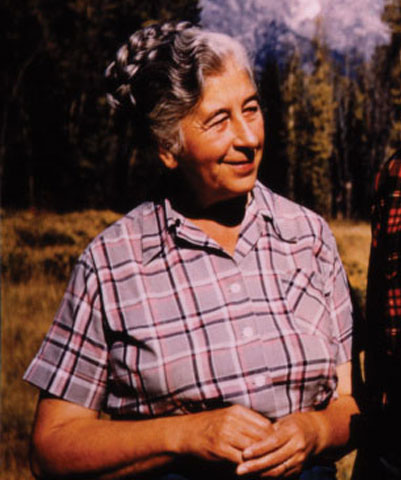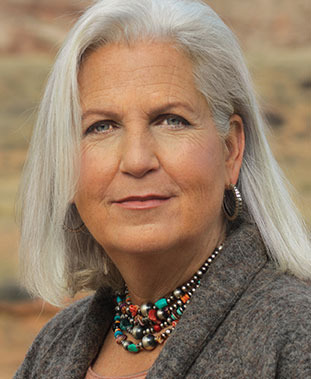

- “Grandmother of the Conservation Movement”
- A founder of the conservation movement in the United States[ka500]
- Writer
- Conservationist
- Explorer
- Naturalist
in Seattle, Washington, U.S.
at 101 years of age
in Moose, Wyoming
- 1962 Two in the Far North
- 1966 Wapiti Wilderness
- 1977 Island Between
- 1924 Was the first woman graduate of the Alaska Agricultural College and School of Mines (which became the University of Alaska Fairbanks)
- 1980 Awarded the Audubon Medal (The Audubon Society’s highest award)
- 1998 Awarded the Presidential Medal of Freedom by President Clinton
- 1983 Awarded the John Muir Award
- 1986 Awarded the Robert Marshall Award (The Wilderness Society’s highest award presented to a private citizen who has never held federal office)[tws500]
- 2002 Awarded the J.N. Ding Darling Conservationist of the Year Award (The National Wildlife Federation’s highest honor)
“The partnership of Olaus and Margaret Murie was a partnership with nature—pure and impassioned. They hold a significant history of the American conservation movement within the framework of their marriage. They initiated and insisted on critical legislation on behalf of wilderness, even the Wilderness Act of 1964. And they did not do it alone. Together they inspired a community of activism.”[tf500]Terry Tempest Williams
“The legacy of Margaret E. Murie is a legacy of love.”[tf500]Terry Tempest Williams
“Mardy Murie, senior woman of the wilderness movement, has helped generations of men and women understand and then articulate their devotion to the work of preserving wild landscapes. She has a grandmother’s poise, a lover’s fire, a spouse’s allegiance, a curandera’s wariness about Congressional platitudes. When she is gone, the land will break down in tears.”[tf2800]Barry Lopez
“Mardy could be up against the most fierce politician who was anti-wilderness, and really touch their hearts with her love of Alaska.”[npr500]Terry Tempest Williams
“I am testifying as an emotional woman and I would like to ask you, gentlemen, what’s wrong with emotion?”[tf700]
“Beauty in a resource in and of itself. Alaska mut be allowed to be Alaska, that is her greatest economy. I hope the United States of America is not so rich that she can afford to let these wildernesses pass by—or so poor she cannot afford to keep them.”[tf700]
“I’m counting on the new generation coming up. I have to believe in their spirit, as those who came before me belieived in mine.”[tf900]
“…words are weak; we use many of them and never really express what is in our hearts.”[tf1000]
“Why shouldn’t one corner of the earth remain ‘unconquered’?”[tf1100]
“Confusing, being a woman, eagerness for new adventure fighting within one with love of cozy home-keeping. Did men ever feel pulled this way?”[tf1200]
“It creates a special kind of feeling to meet another soul unexpectedly in a very large wilderness.”[tf1300]
“People were few and had to make the most of one another’s company; each individual was important.”[tf1400]
“On the frontier, anyone lacking a sense of humor is inevitably weeded out, and only those who can laugh at it all are able to remain.”[tf1500]
“Throughout his study, one fact had impressed him—that somehow the caribou had learned, racially, to keep on the move, so as not to eliminate the food supply in any one place, for the arctic vegetation renews itself slowly, especially the lichens, or “reindeer moss,” which is their favorite, though not their main, food.”[tf1600]
“Imagine an eight-by-ten tent occupied by three caribou hides, including hoofs, various camp equipment, one girl, no reading matter, and you have the picture. I was learning a bit more about being married to a scientist.”[tf1700]
“It seems that to compensate for its fleeting hours, the winter day begins and ends in a riotous prodigality of color—red to rose, to vermilion streaked and fringed with ocher, saffron, lemon—but all so brief, fading as you try to imprit it in memory, now pale green, now the stars; the mountains draw away into darkness, close black ranks of spruce draw near.”[tf1800]
“All our friends, except Jess and Clara, through we were crazy, if not criminal, to take the baby along into the Arctic. I should stay in Fiarbanks. What were we thinking of? The mosquitoes would eat him alive. What if he got sick? What if the men had to go off and leave me alone? What about wild animals? And weren’t the rivers dangerous? And didn’t the men have enough, with navigating and camping out and chasing geese, without a woman and a baby to bother with?”[tf1900]
“We attribute personalitites to all things of nature; I suppose we can’t help it, being the self-centered creatures that we are.”[tf2000]
“Have you ever noticed that books read in the wilderness stay with you a long time? Their entry into your mind is unimpeded.”[tf2100]
“A great bird and a piece of golden sky can give one peace. Watch him as he soars and dips, a graceful pattern with no self-consciousness, there before a golden curtain. The mind is loosed and, emptied of all edged adn clattering thoughts, goes freely floating out to meet the bird. We need such communion; we need to remember we are still animals. After all, intellect is new—how far can we trust it?”[tf2200]
“We cannot blame the plane, the motors, the machines, the inventions. In every phase of life, from the cold war to building new towns, machines will be destroyers or benefactors according to the way in which they are used by man.”[tf2300]
“If man does not destroy himself through his idolatry of the machine, he may learn one day to step gently on his earth.”[tf2400]
“My own overriding thought is: while all this is going on, what is being left for the one industry which can be most lucrative, nondestructive, self-perpetuating, for all time—a commodity in short supply in other world markets—the industry of simply letting people come, look, and enjoy Alaska?”[tf2500]
“I think my main thought is this: that perhaps Man is going to be overwhelmed by his own cleverness; that he may even destroy himself by this same cleverness; and I firmly believe that one of the very few hopes left for Man is the preservation of the wilderness we now have left; and the greatest reservoir of that medicine for mankind lies here in Alaska.”[tf2600]
“…somewhere along the line we have lost control over the beings we have created. We have learned to need all the comforts and refinements and things and gadgets which all the technology has presented to us; we are constantly being bombarded with beguiling messages about how badly we need this or that.”[tf2600]
“Big corporations, big bureaucracies, feed on themselves, become such entities in themselves, so imbued with the great American dream that growth is a god and that the thought of decreasing size and a steady-state society is anathema, that to me they have become terrifying.”[tf2600]
“Yet Man, for all his ego, is not the only creature. Other species have some rights too. Wilderness itself, the basis of all our life, does it have a right to live on? Having furnished all the requisites of our proud materialisitc civilization, our neon-lit society, does it have a right to live? Do we have enough reverence for life to concede to Wilderness this right?”[tf2700]

Terry Tempest Williams
Author, conservationist, activist
Terry was a long-time friend of Margaret and Olaus Murie. In an interview with Image, Terry referrs to Mardy (Margaret) as a mentor to herself and her husband, Brooke.[i500]
Movies
Arctic Dance: The Mardy Murie Story
Directed by Bonnie Kreps
This documentary is a biography of Margaret Murie. This film includes footage from her years spent lobbying for wilderness conservation, a conversation with her friend, Terry Tempest Williams, and photos of Margaret’s time in Alaska.
Books
Two in the Far North
Written by Margaret Murie
Margaret writes about growing up in Fairbanks, meeting her husband, Olaus, exploring the wildernes of Alaska, living in Jackson Hole, and working to protect wilderness.
Wapiti Wilderness
Written by Margaret Murie and Olaus Murie
Olaus writes about working as a field biologist for the U.S. Bureau of Biological Survey and Murie writes about their life together. Includes illustrations by Olaus.
Architecture

The Margaret Murie Building at University of Alaska Fairbanks
Architected by Bezek Durst Seiser & Smith Group JJR[rfd500]
The The Margaret Murie Building serves as a central home for the Department of Biology and Wildlife at the University of Alaska Fairbanks. It includes laboratories, classrooms, office space, and a 150-seat auditorium.[uaf500]
- ⬆ tf500 Murie, Margaret E. Two in the Far North. Alaska Northwest Books, 1997, pp.15. Print. ISBN 978-0-88240-489-9
- ⬆ tf700 Murie, Margaret E. Two in the Far North. Alaska Northwest Books, 1997, pp.11. Print. ISBN 978-0-88240-489-9
- ⬆ tf900 Murie, Margaret E. Two in the Far North. Alaska Northwest Books, 1997, pp.13. Print. ISBN 978-0-88240-489-9
- ⬆ tf1000 Murie, Margaret E. Two in the Far North. Alaska Northwest Books, 1997, pp.101. Print. ISBN 978-0-88240-489-9
- ⬆ tf1100 Murie, Margaret E. Two in the Far North. Alaska Northwest Books, 1997, pp.115. Print. ISBN 978-0-88240-489-9
- ⬆ tf1200 Murie, Margaret E. Two in the Far North. Alaska Northwest Books, 1997, pp.147. Print. ISBN 978-0-88240-489-9
- ⬆ tf1300 Murie, Margaret E. Two in the Far North. Alaska Northwest Books, 1997, pp.158. Print. ISBN 978-0-88240-489-9
- ⬆ tf1400 Murie, Margaret E. Two in the Far North. Alaska Northwest Books, 1997, pp.171. Print. ISBN 978-0-88240-489-9
- ⬆ tf1500 Murie, Margaret E. Two in the Far North. Alaska Northwest Books, 1997, pp.176. Print. ISBN 978-0-88240-489-9
- ⬆ tf1600 Murie, Margaret E. Two in the Far North. Alaska Northwest Books, 1997, pp.179. Print. ISBN 978-0-88240-489-9
- ⬆ tf1700 Murie, Margaret E. Two in the Far North. Alaska Northwest Books, 1997, pp.182. Print. ISBN 978-0-88240-489-9
- ⬆ tf1800 Murie, Margaret E. Two in the Far North. Alaska Northwest Books, 1997, pp.189. Print. ISBN 978-0-88240-489-9
- ⬆ tf1900 Murie, Margaret E. Two in the Far North. Alaska Northwest Books, 1997, pp.212. Print. ISBN 978-0-88240-489-9
- ⬆ tf2000 Murie, Margaret E. Two in the Far North. Alaska Northwest Books, 1997, pp.216. Print. ISBN 978-0-88240-489-9
- ⬆ tf2100 Murie, Margaret E. Two in the Far North. Alaska Northwest Books, 1997, pp.222. Print. ISBN 978-0-88240-489-9
- ⬆ tf2200 Murie, Margaret E. Two in the Far North. Alaska Northwest Books, 1997, pp.253. Print. ISBN 978-0-88240-489-9
- ⬆ tf2300 Murie, Margaret E. Two in the Far North. Alaska Northwest Books, 1997, pp.281. Print. ISBN 978-0-88240-489-9
- ⬆ tf2400 Murie, Margaret E. Two in the Far North. Alaska Northwest Books, 1997, pp.282. Print. ISBN 978-0-88240-489-9
- ⬆ tf2500 Murie, Margaret E. Two in the Far North. Alaska Northwest Books, 1997, pp.356. Print. ISBN 978-0-88240-489-9
- ⬆ tf2600 Murie, Margaret E. Two in the Far North. Alaska Northwest Books, 1997, pp.358. Print. ISBN 978-0-88240-489-9
- ⬆ tf2700 Murie, Margaret E. Two in the Far North. Alaska Northwest Books, 1997, pp.359. Print. ISBN 978-0-88240-489-9
- ⬆ tf2800 Murie, Margaret E. Two in the Far North. Alaska Northwest Books, 1997, Back Cover Print. ISBN 978-0-88240-489-9
- ⬆ npr500 Berkes, Howard, host. “Mardy Murie, Alaska’s Passionate Protector.” All Things Considered, NPR, 29 Nov. 2002. https://www.npr.org/templates/story/story.php?storyId=860015.
- ⬆ ua500 “Margaret Murie Building.” University of Alaska, University of Alaska System, 7 December 2018, https://www.alaska.edu/uajourney/buildings/margaret-murie-building-(/. Accessed 15 August 2019.
- ⬆ uaf500 “Margaret Murie Building.” Campus Map and Visitors’ Guide, University of Alaska Fairbanks, https://www.uaf.edu/campusmap/for-visitors/buildings/murie.php. Accessed 20 September 2019.
- ⬆ rfd500 “Margaret Murie Life Sciences Building.” Research Facilities Design, https://www.rfd.com/_singleproject/margaret_murie_life_sciences_building. Accessed 15 August 2019.
- ⬆ tws500 “Awards.” The Wilderness Society, https://www.wilderness.org/awards. Accessed 16 August 2019.
- ⬆ i500 Hart, Heidi. “A Conversation with Terry Tempest Williams.” Image Journal, Center For Religious Humanism, https://imagejournal.org/article/conversation-terry-tempest-williams/. Accessed 21 September 2019.